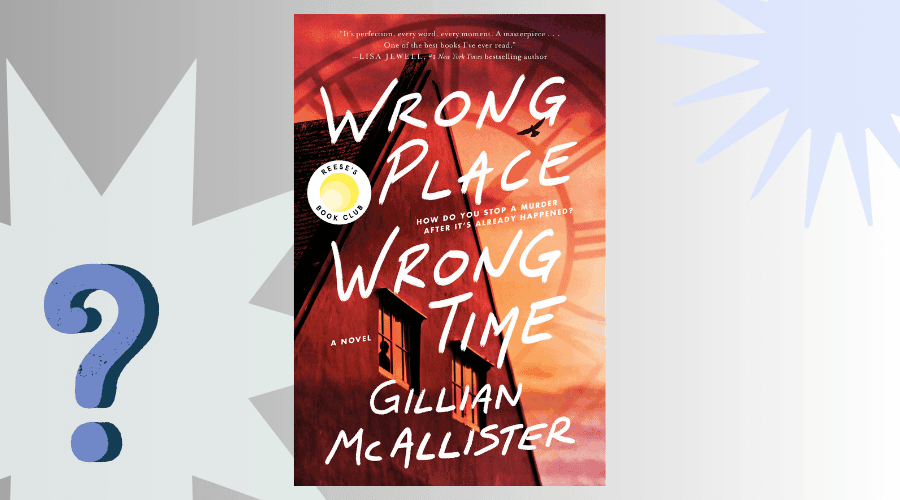Wrong Place Wrong Time would be a great choice for a book club! It offers plenty of material for discussion, from the unique time-loop premise to its exploration of complex family dynamics, guilt, and the consequences of our choices. The twists and emotional depth can spark debates and differing interpretations, which is always fun for a group discussion. Plus, the book raises thought-provoking questions about fate, free will, and memory, making it a good conversation starter. It’s also a relatively fast-paced read, so it should keep your book club engaged and eager to discuss it.
20 Wrong Place Wrong Time Book Club Questions
Here are 20 book club discussion questions for Wrong Place Wrong Time by Gillian McAllister:
- What was your initial reaction to the time-loop premise of the book? Did it surprise you, or did you see it coming?
- How did Jen’s character evolve throughout the novel? What were some key moments in her journey?
- How did you feel about Todd’s character? Did your opinion of him change as the story progressed?
- What role does guilt play in the story, and how does it affect Jen’s actions?
- The book explores themes of fate versus free will. Do you think Jen could have prevented the crime, or was it inevitable?
- How does the structure of the book (the time loops) affect the pacing and suspense of the story?
- What do you think of the relationship between Jen and her husband? How does it impact Jen’s choices?
- How does the book address the idea of family secrets? What role do they play in the unfolding of the plot?
- The story plays with the idea of memory and perception. How reliable do you think Jen’s perspective is throughout the book?
- Did you find the ending satisfying? Why or why not?
- The book has a psychological element with twists and surprises. How well did McAllister execute these elements to keep you hooked?
- How do Jen’s interactions with Kelly help her throughout the story? What does Kelly represent for Jen?
- What do you think the time loops symbolize in terms of Jen’s emotional state and her relationships?
- How does McAllister use suspense and mystery to drive the story forward? Was there a moment that truly shocked you?
- What role does social media and modern technology play in the story? How do they affect Jen’s understanding of events?
- How do you think the story would have unfolded if Jen had not been able to relive the same day? Would she have discovered the truth?
- Did the book change your perspective on how small decisions can have far-reaching consequences?
- If you were in Jen’s shoes, what would you have done differently in trying to prevent the crime?
- How does the setting of the story (the suburban neighborhood, the quiet home) contribute to the suspenseful tone of the novel?
- Would you recommend Wrong Place Wrong Time to others? Why or why not?
These questions should spark engaging and insightful discussions about the book’s themes, characters, and plot twists in your book club!
Wrong Place Wrong Time: Discussion Topics
Here are some discussion topics for Wrong Place Wrong Time by Gillian McAllister that would work well for a book club:
- Time Loops and Their Impact on the Story: Discuss the significance of the time-loop structure in the novel. How does the repetition of days affect the pacing and build suspense? Do you think this narrative technique is effective in delivering the story?
- The Role of Fate vs. Free Will: The novel raises questions about fate and free will. Do you think Jen’s actions can change the outcome, or are events destined to happen no matter what? How does this tension between fate and choice shape the characters’ decisions?
- Jen’s Emotional Journey: Jen goes through an emotional rollercoaster in the book. How does her perspective on motherhood, guilt, and responsibility evolve as she relives the same days? Discuss how her character changes over the course of the story.
- The Nature of Family Secrets: The novel delves into family secrets, with Jen slowly uncovering truths about her son and her own life. How do these secrets shape the characters and their relationships? What do you think McAllister is trying to say about the impact of hidden truths?
- Guilt and Responsibility: Jen feels a strong sense of guilt throughout the book. How do the themes of guilt and responsibility play into her decisions? What does the novel suggest about how we handle guilt in the face of a tragedy?
- Character Development of Todd: Todd’s character is central to the plot, but we see him mostly through Jen’s eyes. How did your perception of Todd evolve throughout the story? Was he a sympathetic character, or did your view of him change by the end?
- Exploring Memory and Perception: The book raises questions about the reliability of memory. How does Jen’s perception of events shift as she relives them, and how does this affect the reader’s understanding of what really happened?
- The Role of Secondary Characters: Characters like Kelly, Jen’s friend, and Detective Raza are important in moving the story forward. Discuss their roles in the narrative. How do they support Jen, and what do they represent in the story’s themes?
- The Effect of Modern Technology: How does modern technology, like social media or surveillance, play a role in how the characters uncover information and solve the mystery? What does it say about how we engage with events in our own lives?
- The Ending and Its Significance: Discuss the ending of the book. Do you find it satisfying? Why or why not? What does the ending say about the nature of time, choices, and family?
- Psychological Suspense vs. Action: This book is more about psychological suspense than physical action. How does McAllister build tension without relying on traditional action scenes? Was this approach effective in maintaining interest?
- The Theme of Protection and Love: Jen’s actions are motivated by a desire to protect her son. Discuss the complexities of maternal love in the book. How does the novel portray the lengths to which a mother will go for her child?
- The Setting’s Contribution to the Atmosphere: The book is set in a quiet suburban neighborhood, which contrasts with the emotional and psychological turmoil the characters experience. How does this setting contribute to the overall atmosphere of the novel?
- Reliving the Same Day: A Personal Reflection: If you could relive a day of your life, what would you change or do differently? How does this idea of re-experiencing a day resonate with the themes of the book?
- Lessons Learned from the Novel: What are some key takeaways from the novel in terms of how we deal with regret, guilt, or family issues? Did the book change your perspective on the consequences of your actions?
These discussion topics will help your book club dive deep into the themes, characters, and narrative structure of Wrong Place Wrong Time, sparking thoughtful conversations and differing interpretations.
Wrong Place Wrong Time Book Club Food Ideas
Here are some more specific Wrong Place Wrong Time themed food ideas that align with the book’s elements:
- Time Loop Tacos: Serve tacos with various fillings and toppings, representing the repeating cycles. You can even offer a fun “build-your-own taco” station, allowing guests to customize their taco with a variety of ingredients, just like the time loops keep changing with new details.
- Deja Vu Donuts: Donuts are perfect for the theme of repetition. Serve different flavors of mini donuts as a nod to Jen reliving the same day over and over. You can even add a twist by offering filled donuts to represent hidden secrets or mysteries.
- Repeatable “Loop” Brownies: Prepare brownies in a circular shape or layered as “looped” brownies to mimic the story’s time loops. You could also make mini brownie bites for easy snacking while discussing the book.
- Parallel “Twinning” Sandwiches: Make sandwiches in pairs (like peanut butter & jelly, or ham & cheese) to represent the duality of choices, where Jen faces two different versions of the same day. You could also use matching cookies or mini sliders to carry this idea through.
- Memory Lane Cupcakes: Decorate cupcakes with symbols of memory, like tiny clocks, keys, or photographs, to represent Jen’s attempt to piece together the past. The cupcakes can also be layered, symbolizing the way she unravels new truths with each time loop.
- “The Final Twist” Popcorn: A large bowl of popcorn with a mix of sweet and salty toppings, like caramel drizzle and sea salt, reflects the surprises and twists in the plot. You could even call it “The Final Twist” popcorn as a fun nod to the ending.
- Time Traveler’s Tea: Serve tea (a British classic) with a fun twist, like lavender tea or fruit-infused iced teas, symbolizing the journey through time. You could even serve it in vintage teacups for added atmosphere.
- Clockwork Cheese Board: Create a cheese board with cheeses cut into clock shapes, representing the passage of time. Pair it with a selection of crackers, nuts, and fruits that reflect the different “moments” Jen revisits.
- The Looping Fruit Salad: Serve a fruit salad arranged in concentric circles or layered, to represent the repeating days and how each cycle reveals something new. Consider adding citrus fruits for a refreshing and light touch.
- Time-Bending Drinks: Create layered drinks (like a layered cocktail or mocktail) that change color or taste as they’re stirred, symbolizing how Jen’s perception of time shifts as she relives the same day.
These themed foods can make your book club meeting more immersive, bringing the concepts of time loops, family dynamics, and mystery to life through your snacks and drinks!

